View in other NatureServe Network Field Guides
NatureServe
Montana
Utah
Wyoming
Idaho
Wisconsin
British Columbia
South Carolina
Yukon
California
New York
Bristly Sedge - Carex comosa
State Rank Reason (see State Rank above)
Only one known location in Montana on the shore of Flathead Lake. Occurrence is threatened by erosion caused by wave action and artificially high lake levels.
- Details on Status Ranking and Review
Population Size
Score3 - Vey Small: Generally <2,000 individuals.
CommentEstimate based upon limited data.
Range Extent
Score1 - Peripheral, Disjunct or Sporadic Distribution in MT: Widespread species that is peripheral, disjunct or sporadically distributed within MT such that it occurs in <5% of the state (<7,500 sq. miles or the combined area of Beaverhead and Ravalli Counties) or is restricted to 4-5 sub-basins.
Area of Occupancy
Score3 - Very Low: Generally occurring in 3 or fewer Subwatersheds (6th Code HUC’s).
Environmental Specificity
Score0-1 - Low to Moderate.
Trends
Score1-3 - Declining: Species is likely declining though the magnitude of declines is uncertain. Declines may be based upon range extent and/or occupied area in the recent past (approximately 30 years).
CommentTrends are unknown, though declines appear to be likely.
Threats
Score3 - Very High: >70% of the populations are being negatively impacted or are likely to be negatively impacted in the near future by one or more activities or agents that are expected to result in decreased populations and/or decreasing habitat quality and/or quantity.
CommentApparently threatened by erosion caused by wave action and artificially high lake levels.
Intrinsic Vulnerability
Score0-1 - Low to Moderate Vulnerability.
Raw Conservation Status Score
Score
11 to 15 total points scored out of a possible 19.
General Description
Short-rhizomatous. Stems erect, 50–100 cm, tufted. Leaves: basal and cauline; blades 5–12 mm wide. Inflorescence of 5 to 9 overlapping, pedunculate spikes; the lowest bract equal to or longer than the inflorescence. Spikes unisexual; the uppermost 1 to 4 male, linear; the lower female, 3–7 cm long, cylindric, spreading to nodding. Perigynia spreading, pale green, lanceolate, veiny, glabrous, 6–9 mm long including a deeply divided beak, 3–5 mm long with long spreading tips; stigmas 3. Female scales tan, lanceolate, awned, shorter and narrower than the perigynia. Achene 3-sided, smaller than the inflated perigynium (
Lesica et al. 2012. Manual of Montana Vascular Plants. BRIT Press. Fort Worth, TX).
Phenology
Fruit matures in July.
Diagnostic Characteristics
Other closely related coarse sedges with nodding spikes are Carex hystricina and sometimes C. utriculata, but neither of these species have perigynia with sharp-pointed, spreading lobes. A hand lens will be needed to observe these characters.
Species Range
Montana Range
Range Descriptions
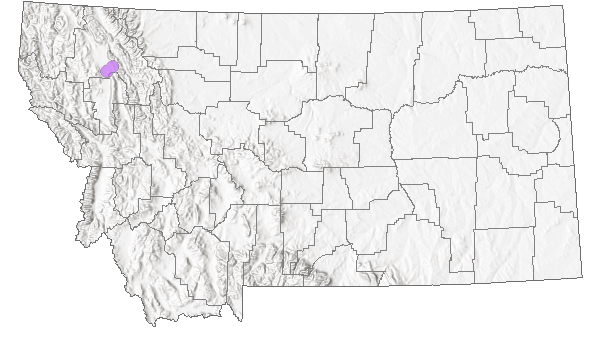
 Native
Native
Range Comments
ON, QC south to TX, MS, SC, disjunct in WA to MT south to CA. Known from Flathead County (Lesica et al. 2012. Manual of Montana Vascular Plants. BRIT Press. Fort Worth, TX).
Observations in Montana Natural Heritage Program Database
Number of Observations: 3
(Click on the following maps and charts to see full sized version)
Map Help and Descriptions
Relative Density
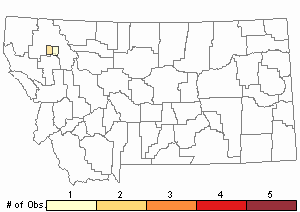
Recency
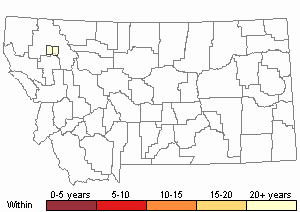

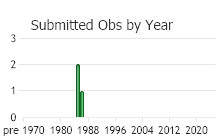
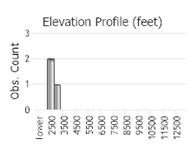 (Observations spanning multiple months or years are excluded from time charts)
(Observations spanning multiple months or years are excluded from time charts)
Habitat
Marshes in the valleys.
National Vegetation Classification System Groups Associated with this Species
Wetland and Riparian
Alkaline - Saline Wetlands
Wet Meadow and Marsh
Stewardship Responsibility
Threats or Limiting Factors
STATE THREAT SCORE REASON
Reported threats to Montana’s single population of Bristly Sedge are due to wave erosion impacts to its shoreline habitat (MTNHP Threat Assessment 2021). Excess annual wave action impacts this population because lake level management excludes a natural seasonal water regime in which wave action is distributed at a range of elevations.
References
- Literature Cited AboveLegend:
 View Online Publication
View Online Publication Lesica, P., M.T. Lavin, and P.F. Stickney. 2012. Manual of Montana Vascular Plants. Fort Worth, TX: BRIT Press. viii + 771 p.
Lesica, P., M.T. Lavin, and P.F. Stickney. 2012. Manual of Montana Vascular Plants. Fort Worth, TX: BRIT Press. viii + 771 p. MTNHP Threat Assessment. 2021. State Threat Score Assignment and Assessment of Reported Threats from 2006 to 2021 for State-listed Vascular Plants. Botany Program, Montana Natural Heritage Program, Helena, Montana.
MTNHP Threat Assessment. 2021. State Threat Score Assignment and Assessment of Reported Threats from 2006 to 2021 for State-listed Vascular Plants. Botany Program, Montana Natural Heritage Program, Helena, Montana.
- Additional ReferencesLegend:
 View Online Publication
View Online Publication
Do you know of a citation we're missing? Bernard, J. M. 1989. Life history and vegetative reproduction in Carex. Canadian Journal of Botany 68: 1441-1448.
Bernard, J. M. 1989. Life history and vegetative reproduction in Carex. Canadian Journal of Botany 68: 1441-1448. Lesica, P., K. Lackschewitz, J. Pierce, S. Gregory and M. O'Brien. 1986. Noteworthy collections: Montana. Madrono 33:310-312.
Lesica, P., K. Lackschewitz, J. Pierce, S. Gregory and M. O'Brien. 1986. Noteworthy collections: Montana. Madrono 33:310-312. Lesica, P., M.T. Lavin, and P.F. Stickney. 2022. Manual of Montana Vascular Plants, Second Edition. Fort Worth, TX: BRIT Press. viii + 779 p.
Lesica, P., M.T. Lavin, and P.F. Stickney. 2022. Manual of Montana Vascular Plants, Second Edition. Fort Worth, TX: BRIT Press. viii + 779 p.
- Web Search Engines for Articles on "Bristly Sedge"





